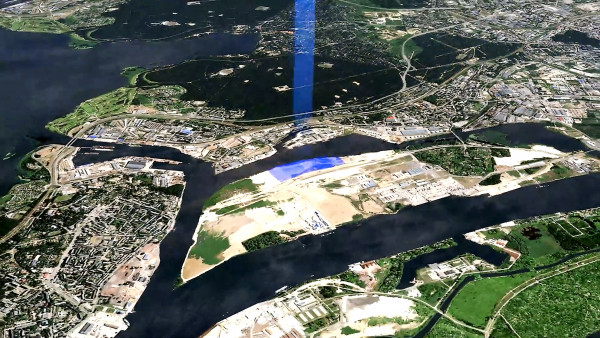Latvia has a chance to get a better LNG terminal in Riga
In order for Latvia to get its own LNG terminal, which would ensure the country's energy independence by operating according to fair market rules and not burdening the population with unfulfillable obligations, the coalition should withdraw the informal promises made during the backroom negotiations to one particular developer, Skulte LNG Terminal.
The developer's publicly listed beneficiary is an American named Peter A. Ragauss. The essence of his offer is to anchor a giant barge in the bay opposite Saulkrasti and pump gas from it to the Inčukalns underground storage facility. In order to allow the developer to legally override the objections of the resort's residents and nationalize their landscape, beach, summer cottages and land needed for the gas pipeline, the project has been unofficially promised the status of an object of national interest, as well as a monopoly on guaranteed gas purchases. However, this has not yet been made official, and as another potential LNG terminal developer has appeared on the horizon - in Riga, developers represented by the American Peter A. Ragauss have hastily submitted an official offer for the LNG terminal to the Latvian government.

Money in the Three Seas Initiative
The developers of the Skulte terminal have not disclosed the sources of financing for the project on their website, or anywhere else so far, and one can guess why. They plan to build the terminal using public funds. Neatkarīgā has already reported that "Coalition priority - superproject Skulte LNG Terminal" is being promoted for funding by the Three Seas Initiative under the auspices of the government. This initiative is essentially a political international business instrument. The three seas are the Baltic, Black and Adriatic Seas, and 12 countries bordering them have agreed to promote infrastructure projects in the transport, energy and digitalization sectors through joint investment. The management of the joint pot has been entrusted to Amber Infrastructure Group, a US-based investment company. Latvia, for its part, has injected seed money of €20 million through the development finance institution ALTUM. A list of eight projects of priority interest has also been submitted for funding. These are: the Rail Baltica railway, wind farm development, smart lighting technologies, mobility solutions, the Salaspils-Baltezers road section, cross-border fiber network development, cross-border data center development, and an offshore LNG terminal. This is clearly the Skulte LNG Terminal project, which has been unofficially received promises to raise money, guarantee a market and silence the cries of the people of the resort town of Saulkrasti.
The most suitable location is Riga
The perfect opportunity for the Skulte project lobbyists to move the funding issue forward will be at the end of June, when the Three Seas Initiative Summit and Business Forum will take place in Riga. But now a problem has appeared on the horizon in the form of a strong competitor. While the American Peter A. Ragauss was pushing his gas project in a pub with the Minister of Justice Jānis Bordāns, another American company, Millennium Energy Partners LLC, was pushing a competing LNG terminal project in the port of Riga, and they have got much further because, firstly, they plan to invest their own money, not money provided by the Latvian state; secondly, the chosen location is much more suitable for such economic activity - the industrial zone of the Port of Riga in the southern part of Kundziņsala. Thirdly, the amount of guarantees required from the government is significantly lower. Less is known about this project because its business plan was designed from the outset on a commercial market basis, without the need for public funding, state subsidies, a new OIK and a procurement monopoly. It is true, however, that the initial planned volumes were in line with pre-war market demand for LNG. Around 300,000 tons per year. For more information on the project, see here. Now that Latvia urgently needs to disconnect from the Russian gas pipe, the developers are considering expanding the project to 1,000,000 tons of LNG per year. And not only to deliver the gas to the recipients by tanker, as originally planned, but also to inject it into the existing Gaso pipeline system. This will allow the gas to be supplied to the largest consumer - Riga - and also to fill the Inčukalns natural gas storage facility.
There will be an alternative if there is no monopoly
But there is also a key precondition: if the project is expanded, the company needs proof that someone will need the gas it supplies. Here is what Lasha Shanidze, Chairman of the Board of Millennium Energy Partners LLC, had to say about the cost of the project and the necessary government guarantees in an interview with the national news agency LETA:
"Our project is worth €120 million. We are not looking for any investment or guarantees from the state. This is a fully commercial project. At the same time, gas buyers are needed to make this project work, because there is no need to fill the infrastructure with gas if they are not going to buy it. So we are not asking for guarantees in the classical sense, but we need an agreement with the recipients that they need the gas."
Basically it follows from the above that the terminal in Riga will happen anyway, but it will only have the capacity to guarantee Latvia's energy independence if the entire Latvian LNG market is not monopolized in favor of one particular player - the American Peter A. Ragauss and his dreamed-of Skulte terminal, as was agreed over a glass of beer in a pub a few years ago.
*****
Be the first to read interesting news from Latvia and the world by joining our Telegram and Signal channels.
